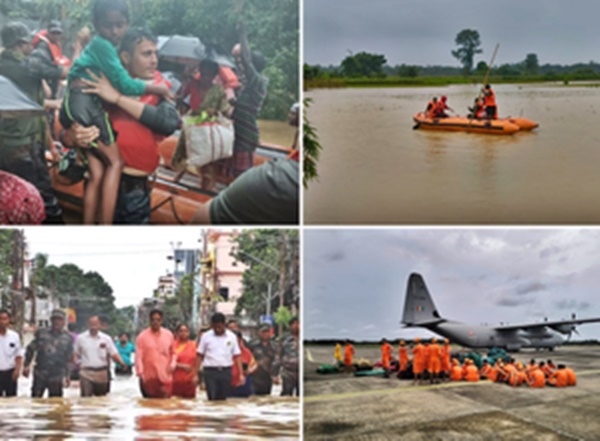The National Disaster Response Force (NDRF) has conducted an extensive flood rescue operation in Tripura, evacuating 1,479 people amid severe flooding that has affected several districts in the state. The NDRF teams, along with local authorities, have been working tirelessly to provide relief and ensure the safety of those stranded due to the rising water levels.
Extensive Flooding in Tripura
Tripura has been facing severe monsoon rains, which have resulted in widespread flooding across multiple districts, including West Tripura, Sepahijala, and Gomati. The heavy downpour has caused rivers to overflow, inundating low-lying areas and displacing thousands of residents. The situation has been further exacerbated by landslides, which have blocked several roads, making it difficult for rescue operations to reach affected areas.
The state government has declared a state of alert in the worst-hit regions and has set up relief camps to accommodate those who have been displaced. The continuous rainfall has also disrupted normal life, with schools and offices remaining closed and transportation services being severely affected.
NDRF’s Swift Response
In response to the crisis, the NDRF deployed multiple teams to the flood-affected areas to carry out rescue and evacuation operations. The teams, equipped with boats, life jackets, and other necessary equipment, have been working round the clock to evacuate stranded residents to safer locations. As of now, the NDRF has successfully evacuated 1,479 people, including elderly citizens, women, and children, who were trapped in their homes due to the rising floodwaters.
The NDRF’s prompt and coordinated response has been lauded by both the state government and the local population. The force’s ability to quickly mobilize and reach even the most remote and affected areas has been crucial in minimizing the loss of life and ensuring the safety of residents.
Relief Measures and Challenges
In addition to rescue operations, the NDRF and state authorities have been actively involved in providing relief materials to those affected. Essential supplies, such as food, water, and medical aid, have been distributed to the evacuees at various relief camps set up by the government. The authorities are also taking measures to prevent the spread of waterborne diseases, which are common in flood-affected areas.
However, the rescue and relief efforts have not been without challenges. Continuous rain and poor visibility have hampered aerial reconnaissance and relief efforts. Additionally, landslides and damaged infrastructure have made it difficult for rescue teams to reach some of the more isolated areas. Despite these obstacles, the NDRF and local authorities remain committed to their mission of ensuring the safety and well-being of Tripura’s residents.
Government’s Response and Future Plans
The Tripura government has been closely monitoring the situation and coordinating with central agencies to ensure a swift and effective response to the crisis. Chief Minister Manik Saha has held several high-level meetings with officials from the disaster management department and has assured that all necessary resources will be made available to aid in rescue and relief efforts.
The government has also appealed to the public to remain calm and cooperate with rescue teams. Evacuation orders have been issued in several low-lying areas, and residents have been urged to move to higher ground and take shelter in designated relief camps.
Looking ahead, the Tripura government is planning to implement more robust flood management and mitigation measures to better prepare for future monsoon seasons. This includes improving early warning systems, reinforcing embankments, and enhancing the capacity of local disaster response teams.
The NDRF’s extensive flood rescue operation in Tripura highlights the challenges and complexities of disaster management in the face of severe natural calamities. While the successful evacuation of 1,479 people is commendable, it also underscores the need for continued vigilance and preparedness to handle such emergencies. As Tripura continues to grapple with the effects of the monsoon, the collaboration between state authorities and central agencies remains vital in safeguarding the lives and livelihoods of its residents.



